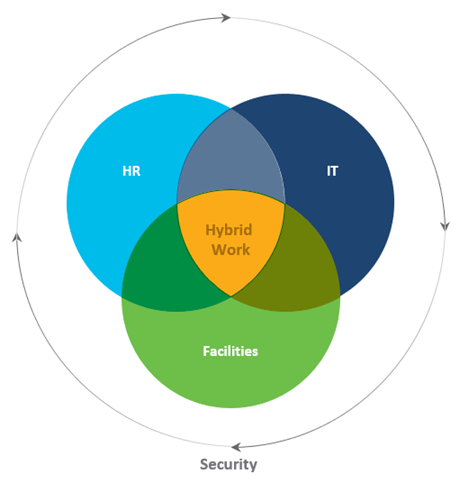- This video doorbell camera has just as many features are my Ring - and no subscription required
- LG is giving away free 27-inch gaming monitors, but this is the last day to grab one
- I tested this Eufy security camera and can't go back to grainy night vision
- I replaced my iPhone with a premium dumbphone - here's my verdict after a month
- Build your toolkit with the 10 DIY gadgets every dad should have
Hybrid work: what’s possible when 3 key domains come together – Cisco Blogs

In collaboration with Joel Barbier
Like most companies, Cisco has seen a dramatic shift in employees’ attitudes and behaviors regarding remote work since the beginning of the COVID-19 pandemic. For example, the percentage of employees surveyed who prefer to work from home at least once a week rose from 48% to 91%, while the percentage of meetings with at least one remote participant are projected to grow from 8% to 98%.
However, these changes also reflect the increasing adoption of a “hybrid work” model by Cisco and many other companies over the past few years. This new approach is driven by several key factors:
- Greater availability of collaborative technologies that support remote work
- Employees’ growing desire for a better work/life balance, with schedules that allow them to work when they’re most productive
- The imperative to attract employees from around the globe – and to offer flexible working arrangements that help retain employees
- The need to provide a highly inclusive, equitable work environment for all employees, regardless of their location or time zone The desire to reduce underutilized office space, with a goal of saving money and improving the company’s environmental impact (less energy usage in buildings, fewer employees commuting each week)
Hybrid work is not just about remote work. Cisco defines “hybrid work” as “an approach that designs the work experience around and for workers, wherever they are. It empowers people to work onsite, offsite, and when moving between locations. Hybrid work also promotes inclusiveness, engagement, and well-being for all employees.”
The shift to hybrid work can be difficult – and some will fail
According to industry analyst firm Forrester, 60% of organizations will shift to a hybrid work model in 2022 – but one-third will fail in their first attempt.[i] Why? In a nutshell, the move to a hybrid work model is hard.
For one thing, the shift requires organizations to restructure expectations around meetings, job roles, and promotion opportunities so they’re no longer reliant on in-person experiences. Another hurdle is acceptance by some executives. A recent PwC study found that when it comes to hybrid work, the biggest challenge for executives is their concern about how it might erode their corporate culture.[ii]
For the hybrid work model to work, leadership and culture must be aligned – with digital infrastructure forming the foundation of the hybrid work experience. To accomplish this, Cisco believes that hybrid work solutions must be:
- Inclusive: Provide a work environment in which every person can fully participate and be seen and heard equally.
- Flexible: Harness flexible tools that adapt to the work styles, roles, and devices of employees who may be spread across many time zones.
- Supportive: Promote a supportive mind-set throughout each level of the organization to ensure that employees feel comfortable, safe, and secure about new ways of working.
- Secure: Ensure secure, worry-free connectivity and app experiences for all workers.
- Easy to manage: Make it easy for IT teams to provision users and devices at scale; access robust, relevant analytics; and troubleshoot issues with “single pane of glass” visibility into users and devices.
Recipe for success: HR, IT, and Facilities working in concert
While some people might think of hybrid work strictly as a technology initiative, its success relies heavily on three teams – HR, IT, and Facilities working in concert.
HR: Cisco’s adoption of the hybrid work model has become an essential tool for attracting and retaining employees. In a recent global workforce survey workers said they would consider a new position or job only if it allowed for flexible hours.[i] Clearly, not supporting a hybrid work model could prevent companies from attracting and retaining the talent they need to succeed in the future.
IT: Cisco is using technology to simplify and personalize our way of working, with a goal of boosting employee productivity, collaboration, engagement, and inclusion. More specifically, technology is producing data insights that will help us improve employees’ work/life integration and build higher-quality connections among individuals and teams. It’s also allowing us to adopt a zero-trust approach to securing access across company networks, applications, and environments from any user, device, and location.
Facilities: Over the past 25+ years, Cisco’s Facilities team has continually modified our working environment fit the company’s culture and objectives. When utilization of office space decreased as employees started working from home more often, Facilities changed the emphasis in Cisco buildings from individual spaces (5%) to collaborative spaces (95%). While Facilities will continue to look for opportunities to reduce the company’s overall office footprint, it will also aim to create workspaces that can serve as a central hub for workers to engage in rich, collaborative experiences with colleagues.
One prime example of how Cisco’s HR, IT, and Facilities teams collaborated to enable a true hybrid work environment is the evolution of our “Cisco Check-in” sessions, which company leadership use to share information and provide strategic directions to employees. The concept began in 2019 when Cisco launched its Cisco Beat sessions, which were available on any device anywhere, with both live and virtual audiences. By 2020 and the arrival of the pandemic, Cisco Beat evolved to become the Cisco Check-in, with an emphasis on engagement, experience, emotion, and well-being. Held every two weeks, the Check-ins have provided an effective platform for addressing employee isolation during the pandemic; taking employee feedback via live polls; focusing on employee mental wellness; and answering health-related questions.
Impact of hybrid work model for Cisco:
Improved productivity, lower costs, better employee experience & sustainability
Since 2012, Cisco’s hybrid work evolution has generated tangible benefits in several key areas:
- Employee productivity: Hybrid work now enables Cisco knowledge workers to save more than two hours daily, representing $2.5 billion in yearly value to the company. These productivity gains are from time savings realized by Cisco employees when they use the portfolio of collaboration solutions.
- Workplace: Hybrid work has allowed Cisco to optimize space usage and close 425 buildings. Proceeds from building sales have totaled $452 million, with an additional $80 million projected during the current fiscal year.
- Employee experience: By improving Cisco’s ability to accommodate a variety of working styles, hybrid work has helped boost employees’ work/life balance satisfaction rating to its highest level ever. The company also has been named one of the “Fortune 100 Best Companies to Work For” five years in a row (2017-2021).
- Sustainability: Even before the pandemic, hybrid work was responsible for Cisco employees commuting an average of 5 fewer times per week. Hybrid work has enabled Cisco to avoid 240K MWh of energy usage. In 2021 alone, the company reduced its CO2e footprint by 93.4K tons, representing $29 million in OpEx savings.
These results prove that when three domains – HR, IT, and Facilities – come together, they enable the hybrid working model to reach its full potential.
[i] Susan Galer, “Workforce Trends 2022: How Companies Are Building Digital Dream Teams,” Forbes, January 18, 2022
[ii] “PwC US Pulse Survey: Next in Work,” PwC, 2021
Follow Cisco IT on social!
Share:


